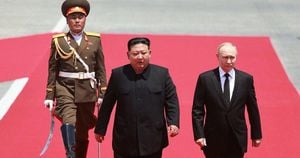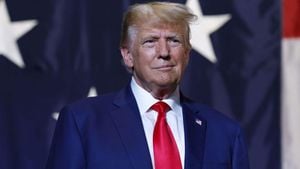President-elect Donald Trump has reignited trade tensions with his bold proposals to impose steep tariffs on imports from major trading partners like Canada, Mexico, and China. Announced via social media on the evening of November 27, 2024, Trump’s tariffs aim to impose 25% duties on goods from Canada and Mexico, alongside a 10% levy on Chinese imports. This move has raised alarms among economists and politicians, who suggest these tariffs could lead to heightened inflation and adverse economic impacts on American households.
The urgency of this situation is felt across various sectors as businesses scramble to adapt. Following Trump’s statements, firms across the country, such as MinkeeBlue, led by handbag designer Sherrill Mosee, are gearing up for changes, shifting supply chains and revising contracts to mitigate financial risks associated with these potential tariffs. “I’m like, okay, we’ve got to bring those in,” said Mosee, referring to her preparations for newly ordered goods not yet shipped. This sentiment echoes the anxiety felt among many small business owners, who fear the economic strain from impending tariff implementations.
Economic experts have analyzed the consequences these tariffs could hold, with some estimating the average American family may see their annual costs rise significantly—by as much as $4,000 per year depending on the tariffs’ final structure. Gary Hufbauer, a senior fellow at the Peterson Institute for International Economics, noted, “About 15% of goods consumed in the United States are imported,” emphasizing how broad tariffs would impact consumer prices and overall cost of living.
Not only would consumers feel the sting, but many industries could face significant challenges. The automotive sector, for example, which heavily relies on integrated North American supply chains, could see considerable price increases. According to Hufbauer, commodity prices will likely climb if tariffs are enacted, making it harder for manufacturers and raising the cost of goods for consumers.
Democrats swiftly responded to Trump’s tariff threats by introducing legislation aimed at restricting the president's ability to implement these taxes without Congressional oversight. Prominent lawmakers, including Suzan DelBene and Don Beyer, articulated concerns about the potential fallout such tariffs could entail for American consumers and the economy at large. DelBene stated, “Imposing sweeping tariffs on imported goods would raise prices on consumer products by thousands of dollars a year,” underpinning their commitment to address this controversial issue.
The international ramifications of Trump’s proposed tariffs extend beyond U.S. borders, significantly affecting foreign relations, particularly with U.S. allies. South Korea, deeply invested with substantial business interests across North America, is particularly anxious about potential tariffs. Their presidential office has met to devise strategic responses, as tariffs on Canadian and Mexican goods could severely impact Korean companies exporting to the U.S. market. Sung Tae-yoon, from the South Korean presidential office, emphasized the need for readiness against such unexpected changes, stating, “We need to prepare ourselves for anything.”
Meanwhile, questions loom about Trump’s intentions. Some analysts suggest his ardent statements may not translate to immediate actions, framing them more as strategic positioning for upcoming negotiations over broader trade and immigration policies. Yet the economic effects of his rhetoric are already palpable, with companies recording upticks in stockpiling behavior and increased inquiries for warehouse space amid public uncertainty.
The forthcoming tariffs on Chinese imports also pose significant concerns for industries reliant on low-cost manufacturing. While Trump argues these tariffs will revitalize U.S. manufacturing and generate job growth, many economists warn they could impede overall employment gains. The National Retail Federation anticipates exorbitant costs for consumers, estimating annual surcharges ranging between $46 billion and $78 billion across several sectors, including apparel and household goods.
Strikingly, Trump's decisions contradict his previous pledges to reduce living costs for Americans. The tension between his promise of lower consumer prices and the potential for increased tariffs creates uncertainty about the future economic climate. Democratic leaders argue the proposed tariffs are excessive and counterproductive, potentially tightening the already stressed economic fabric of American households.
For small businesses like MinkeeBlue, the stakes are particularly high. With less margin to absorb potential price hikes, entrepreneurs are left weighing the risks of future consumer demand against the backdrop of rising operational costs. Mosee, reflecting on her challenges, stated, "It's going to be hard, all the way around." Small brands, eager to capture market share, often find themselves caught between fluctuated costs and intensified competition as they seek new avenues to protect their profitability.
The backdrop of Trump's presidency is littered with similar instances of aggressive trade rhetoric, historically marked by mixed follow-through on economic policies. Despite consistent threats, industry experts remain cautious about the extent of new tariffs and their long-term viability. Brendan Duke, from the Center for American Progress, speculated on future tariff levels, remarking, “We are going to get several tariff threats via rage-posts over the next four years.”
Despite uncertainties surrounding Trump's claims, the immediate reactions from businesses and international partners suggest significant impacts on American commerce. Stockpiling measures, shifting supply chains, and rising retail prices are fast becoming the new norm, all because of the anticipation and fear stemming from Trump’s aggressive tariff proposals. Whether these potential tariffs will solidify or dissipate, one thing remains clear: the economic ripple effects stand poised to reshape how American households will navigate their budgets and expenditures for the foreseeable future.
Beyond the U.S. borders, global markets are already bracing for the repercussions of Trump’s trade policies. Countries such as South Korea, heavily integrated within cross-border supply chains, are urgently reassessing their strategies and evaluating competitive dynamics as they confront rising tariffs. The notion of “America First” echoes through North American trade channels, hinting at the long-term shifts expected to ripple across global economic landscapes if these tariff proposals materialize.



